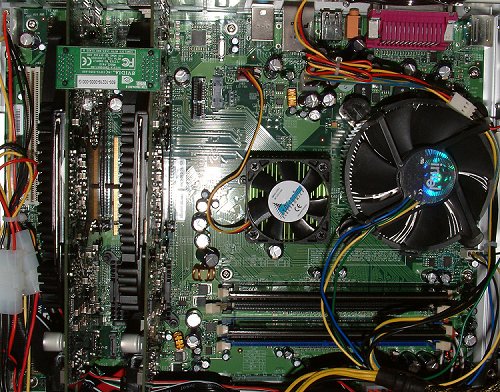The chipset
If you feel you need a primer on SLI, how it works, and what to expect, head over to Ryszard's excellent primer, here. In a nutshell, graphics rendering performance is increased by running two identical NVIDIA cards, bridged, in one system. Cards are installed into 2 x16 PCI-Express lanes and render in one of two modes. Split-frame rendering (SFP), as the name suggests, divides the rendering workload into 2 sections, with each card responsible for either the top or bottom half of the image. Alternative-frame rendering, however, forces each card to render a frame in turn, with each card responsible for one frame at a time. This is a huge simplification, of course, but SLI is a proven technology that NVIDIA inherited and nurtured when it took over 3Dfx.SLI considerations aside, what makes NVIDIA job that little bit trickier for Intel CPUs is in architecting an efficient memory controller. AMD's current S939 CPUs have their own on-chip controller, and all compatible chipsets generally perform, in 2D terms, on a par with one another. Launching an efficient Pentium 4 memory controller is absolutely paramount for NVIDIA's success, both in P4 SLI and non-SLI boards.


Let's digest NVIDIA's first Intel-based chipset from the top. Due to, perhaps, the need to design a memory controller for LGA775 processors, NVIDIA has resorted to a traditional two-chip northbridge/southbridge design that's connected via a high-speed HyperTransport link. That's in stark contrast to the single-chip models for AMD. The nForce4 SLI Intel Edition will support all LGA775 CPUs, including the recently-introduced dual-core Smithfield. However, purchasers of retail motherboards will need to ensure that the nForce4 SLI Intel Edition board they're considering do indeed support the Pentium D and XE 840 models, as partners may elect to produce more than one model on this chipset.
It's nice to see a northbridge-to-CPU bus speed of 266MHz. That gives both overclocking headroom to enthusiasts looking to push their 200MHz FSB P4s to the limit, and, just as importantly, support present and upcoming 266MHz processors. Hyper-Threading support, of course, is present. Emanating from the busy SPP northbridge is NVIDIA's SLI technology on the right-hand side, which allows the use of both single and dual cards (SLI-only). DDR2 support is an Intel-matching 667MHz, with the performance-enhancing 1T address timing available through a dedicated command bus for each DIMM. Looking just below, 3 PCI-Express x1 slots will be enough for most users' needs.
Moving on down to the southbridge, or MCP as NVIDIA likes to call it, storage support is at least as impressive as the equivalent AMD chipset's. MediaShield is NVIDIA's umbrella term for its storage options. 4 SATA-2 ports offer up 300MB/s data transfers apiece, and NVIDIA doesn't skimp on IDE, with 2 regular ATA133 channels. RAID is offered in many flavours, including RAID0, 1, 0+1 and 5. The latter emphasises the 'shielding' nature of the MCP, that is, RAID5's use of at least 3 drives that share information on content amongst one another (parity bits). Further, Native Command Queuing, on-the-fly rebuilds and conversion to different RAID arrays, and hot-plugging are all present. One would need a separate article to highlight the functions and performance of NVIDIA's storage options, so stay tuned.
Continuing the catchy naming scheme is ActiveArmor, which is NVIDIA's integrated Gigabit Ethernet and firewall implementation. The firewall is hardware-based this time, meaning that the usual CPU-intensive activity of sifting through data packets as they arrive at the firewall is now handed over to a dedicated hardware engine, leaving the CPU free for other tasks. Gigabit Ethernet is commonplace on most new chipsets now, but NVIDIA gains some brownie points by having it integrated into the MCP. 10 USB 2.0 ports is bountiful, and whilst 7.1-channel sound looks impressive on a block diagram, NVIDIA has dropped the ever-so-popular nForce SoundStorm in favour of plain old AC'97. It's perplexing to think why the chipset is so advanced in certain areas and fundamentally lacking in selected others. As you'd expect, the nForce4 SLI Intel Edition also sports NVIDIA's auto-overclocking nTune utility.









